Can we help you?
Contact us

Can we help you?
Contact us

Thank you for contacting us
Your form has been submitted successfully Our team will contact you again as soon as possible.
Whooppss...!! An error has occurred
Try sending later or write an email directly to areaempresas@ua.es

 PATENTED TECHNOLOGY
PATENTED TECHNOLOGY
 EXCLUSIVE LICENSED
EXCLUSIVE LICENSED
INFO
SHEET
DOWNLOAD
EXECUTIVE
ABSTRACT
CONTACT DETAILS: Research Results Transfer Office-OTRI
University of Alicante
Tel.: +34 96 590 99 59
Email: areaempresas@ua.es
http://innoua.ua.es
A new high efficiency nebulizer has been developed in collaboration between two Spanish universities and a spin-off company. It is called Flow Blurring Nebulizer (FBN) and is a nebulizer for inductively coupled plasma (ICP) that incorporates the latest technologies and materials. Due to the microfluidic principles, the FBN has proved to be the best existing nebulizer for sample introduction in ICP applications. Researchers are interested in sell the new nebulizer to final customers or companies.

Fundamental characterization
- Highly Efficient Atomization Technology: The Flow Blurring Nebulizer incorporates the most efficient pneumatic atomisation technology, which permits to generate extremely fine sprays with most of droplets below 10 microns (Figure 1). This permits to achieve high transport efficiencies (around 30%) introducing up to six times more sample in the plasma than common nebulizers. In addition, tertiary aerosol is practically contained in droplets smaller than 10 microns (Figure 1) that improves the process in the plasma.
- Broad range of liquid flow rate: The technology incorporated permits to reach stable functioning regimes from as low as 0.005 mL/min up to 3 mL/min. Therefore, in addition to have outstanding performance in conventional flow rates, the FBN will let the user to maintain high sensibility levels when working with very low flow rates, something that, nowadays, is only partially achieved by very specific and limited micronebulizers.
- Excellent performance with high salt content solutions: The Flow Blurring Nebulizer shows outstanding behaviour in an extremely broad range of conditions. Samples with salt concentrations up to 10% NaCl can be nebulized by the FBN without solid deposition and clogging (Figure 2). This excellent behaviour with high salt solutions is reflected on good short-term stability (Figure 3).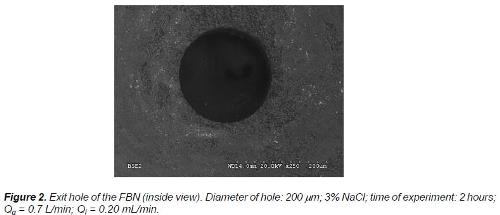
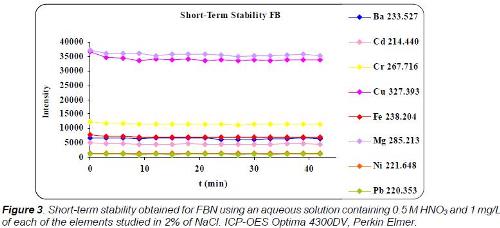
- Other characteristics:
Chemical compatibility: The capillary tube and the plate of the FBN are made from inert polymer, and its embodiment from PTFE with graphite. These highly inert materials make the nebulizer virtually resistant to every type of samples, including those digested with HF.
Non fragile: The FBN is a robust device, due to its plastic body and the carefully designed shape of its tip.
Fitting compatibility: FBN gas and sample admissions are compatible with usual tubings (provided with the nebulizer) that allows easy replacement if required. Furthermore, it is a direct replacement of usual 6 mm diameter nebulizers.
Safety: No high pressure is needed to work properly.
INNOVATIVE ASPECTS
In recent years, the superiority of the prototypes made by the company over current nebulizers has been established by different articles published in prestigious scientific journals. However, our research program went further on, incorporating improved engineering solutions that have finally culminated in the design of the Flow Blurring Nebulizer, the best nebulizer ever made for liquid sample introduction in ICP-based analytical spectroscopy instrumentation.
The FBN has successfully surpassed every conventional nebulizer that has been compared with. Furthermore, the FBN improves the results obtained by micronebulizers in their optimal parametrical range.
As shown in the Figure 4, while other evaluated micronebulizers generate a very high proportion of big droplets (bigger than 20 microns), most of the droplets generated by the FBN are below 10 microns, due to its high energetic efficiency. Hence, under identical working conditions the FBN generates a much finer and monodisperse spray, which means to introduce more sample mass in the plasma and considerably enhance the sensibility and detection limit of the analysis.
- Drop size distribution.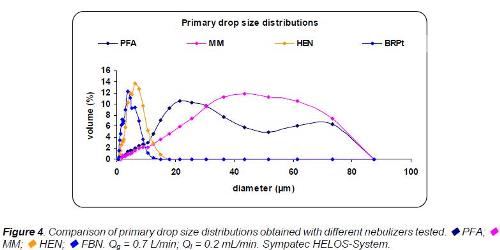
- Figures of merit.
The FBN has been tested and compared, under similar conditions, with other common micronebulizers and has reached sensibility levels up to three times higher (Figure 5).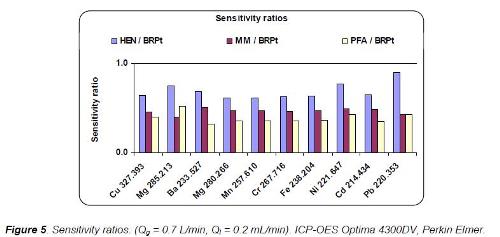
Relative standard deviation values obtained with the FBN are also improved (Figure 6).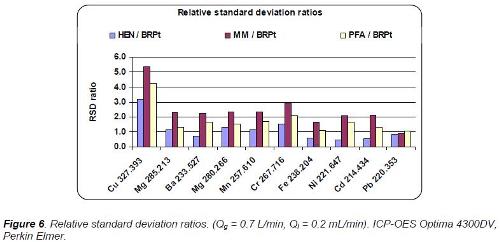
Both improvements shown by the FBN are finally reflected in a clear improvement on limit of detection values (LOD) (Figure 7).
The main innovative aspects include: high atomisation efficiency (most of droplets below 10 microns), the technology allows the user to reach stable regimes from flows as low as 0.005 mL/min up to 3 mL/min, high transport efficiencies, high sensibility, good performance with high salt content solutions and no high pressure needed for its operation.
It will soon become an indispensable tool in every analytical spectroscopy lab devoted to inorganic elemental analysis.
MAIN ADVANTAGES
1. High atomisation efficiency (most of droplets below 10 microns).
2. High transport efficiencies (around 30%) introducing up to six times more samples than common nebulizers.
3. The technology developed allows the user to reach stable regimes from flows as low as 0.005 mL/min up to 3 mL/min.
4. High sensibility levels working with low flows. Sensibility levels three times higher than commercial nebulizers.
5. Excellent performance with high salt content solutions.
6. Chemical compatibility with samples, including samples with HF, etc.
7. No fragile device and no high pressure needed for its operation.
8. Fitting compatibility of the nebulizer.
9. Better behaviour than other commercial nebulizers.
Lab Scale.
In production.
This system may be used by all the laboratories devoted to elemental inorganic analysis based on plasma instrumentation (ICP-AES and ICP-MS). It could be useful in such areas as environmental (drinking water, ambient water, sea water, soils, sludges, solid waste, elemental speciation), food analysis (QA/QC), semiconductor (process chemicals, contaminants in Si wafers, photoresists and strippers), clinical (blood, hair, serum, urine, tissues), forensics (gun shot residue, materials characterization, point of origin, toxicology), geological (soil, rocks, sediments, isotope ratio studies, laser sampling), nuclear (fuel production, measurement of radioisotopes, primary cooling water) and general chemical industry (R&D, QA/QC).
The cooperation is sought to sell the new nebulizer to final customers or companies interested. Other collaborations regarding the exploring of new applications and specific studies to use the new nebulizer are also sought.
The nebulizer has been developed by two Spanish public Universities and a spin-off company. The technology and design of the nebulizer is protected by a broad portfolio of patents. The company owns the rights of such patents and the worldwide license for the commercialization of the new nebulizer.
This technology has been developed in collaboration between researchers from the Analytical Chemistry and Food Sciences Department, in the University of Alicante (Spain), the Department of Fluid Mechanics, in the University of Seville (Spain) and a private company, Ingeniatrics Tecnologías, S.L. (www.ingeniatrics.com).
Some publications in the field of this offer:
1. A.M. Gañan-Calvo and J. Rosell, “Method for producing and aerosol”, patent number: WO 00/76673 A1, 2000.
2. B. Almagro; A.M. Gañan-Calvo and A. Canals, “Preliminary characterization and fundamental properties of aerosols generated by a flow focusing pneumatic nebulizer”, J. Anal. At. Spectrom., 19, 1340-1346 (2004).
3. A.M. Gañan-Calvo; B. Almagro Fernández and A. Canals Hernández, “Procedimiento y dispositivo para la producción de aerosoles líquidos y su uso en espectrometría analítica (atómica y de masas)”, patent no. P200402303, 2004. International patent number: WO 2006/037819 A1 (date: 12/09/2005).
4. B. Almagro; A.M. Gañán-Calvo; M. Hidalgo and A. Canals, “Flow focusing pneumatic nebulizer in comparison with several micronebulizers in inductively coupled plasma atomic emission spectrometry”, J. Anal. At. Spectrom., 21, 770-777(2006).
5. B. Almagro; A.M. Gañán-Calvo; M. Hidalgo and A. Canals, “Behaviour of a flow focusing pneumatic nebulizer with high total dissolved solids solution on radially-and axially-viewed inductively coupled plasma atomic emission spectrometry”, J. Anal. At. Spectrom., 21, 1072-1075(2006).
Pollution and Environmental Impact
Pharmacology, Cosmetics and Ophthalmology
Chemical Technology
Carretera San Vicente del Raspeig s/n - 03690 San Vicente del Raspeig - Alicante
Tel.: (+34) 965 90 9959




